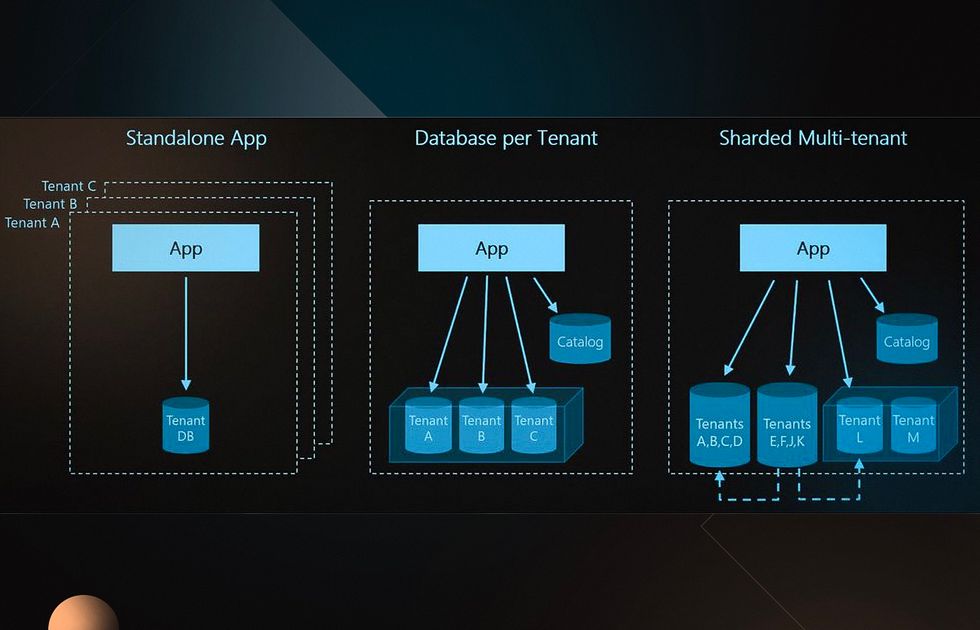
Key Takeaways
- With a SaaS multitenant application, multiple customers or tenants can share a single software instance running on a cloud infrastructure.
- It provides efficient resource use, easy maintenance, customization, rapid scaling, cost-effectiveness, and swift onboarding.
- When building a multi-tenant SaaS platform, consider customization, compliance, support, upgrades, and onboarding.

The SaaS market is booming due to the need for affordable and scalable software solutions. With their help, businesses access applications without costly infrastructure and expand usage as needed. In 2024, the global SaaS market was valued at $358.33 billion. It’s expected to reach $1,251.35 billion by 2034, with a CAGR of 13.3%. Companies like Microsoft, Salesforce, Oracle, and IBM lead the market, using a multi-tenant architecture.
Now, how will your business benefit from implementing a multi-tenant SaaS app? What challenges may you face? And how to build such software optimally? This article will answer all these questions.
Acropolium is a SaaS software development company with 14+ years of successful project experience and 137 delivered solutions. We’ll share some of our knowledge about multi-tenancy for SaaS applications. Also, you’ll learn about our biotech and accounting projects. So, let’s dive in!
What Is Multi-Tenant Data Architecture?

What is multi-tenant SaaS? It’s cloud infrastructure where software instances and supporting infrastructure serve multiple customers (tenants). Users share databases and compute resources, but their data is isolated.
Most subscription-based cloud SaaS solutions rely on a multi-tenant architecture. Some examples of these services include the following:
- Corporate and single-user email apps (Yahoo, Gmail, Outlook)
- Cloud storage services (Google Drive, OneDrive, Dropbox)
- Website platforms (Shopify, Wix)
- Communication apps (Slack, Skype, Trello)
Multi-tenant Architecture Models & Use Cases
Multi-tenant architecture is a cornerstone of cloud computing, enabling resource sharing, scalability, and cost efficiency for various applications. It powers SaaS, PaaS, and IaaS solutions, driving innovation across industries. Let’s dive into the key architectural models and their real-world applications.
Single Application, Single Database
In this model, a single application serves multiple tenants, each with its own database. This setup ensures strong data isolation and security while maintaining a shared application framework. For instance, a cloud-based CRM platform assigns each subscribing company a dedicated database, safeguarding data integrity while allowing tenant-specific customizations.
Single Application, Multiple Databases
This approach involves a single application managing multiple distinct databases, offering a balance between resource sharing and data separation. A content management system might adopt this model, enabling various clients to manage their content independently within the shared platform, ensuring flexibility and control.
Multiple Applications, Multiple Databases
This advanced model incorporates multiple applications, each with its dedicated database, catering to specific business functions. It provides flexibility and scalability, allowing businesses to tailor their application ecosystems. For example, an ERP system might feature independent modules for finance, HR, and logistics, each functioning as an individual application with its own database. Multi-tenancy is indispensable for cloud computing but not universally suitable. Its applications include:
- Software as a Service (SaaS). Multi-tenancy enables SaaS giants like Salesforce and Adobe to efficiently deliver services to diverse customers, maintaining shared infrastructure while ensuring tenant-specific data security.
- Platform as a Service (PaaS). Providers like AWS and Google Cloud leverage multi-tenant models to distribute services across multiple clients, pooling resources and reducing operational costs.
- Infrastructure as a Service (IaaS). IaaS providers, including DigitalOcean and Google Compute Engine, rely on multi-tenancy to allocate resources dynamically, offering cost-effective and scalable solutions.
- Uniform Algorithmic Applications. Applications employing standardized or modular functionality benefit from multi-tenancy by tailoring shared algorithms to client-specific requirements, optimizing resource allocation, and minimizing expenses.
SaaS: Multi-Tenant vs. Single Tenant — What to Choose?
Now, let’s compare multi-tenancy to single-tenant architecture.
Single-tenancy in SaaS refers to a cloud environment where every customer has a separate software instance, database, and a set of computing resources. The tenant’s data is fully isolated and inaccessible to other users. But customers should manually maintain and upgrade their environment.
Single-tenant architecture relies on on-premise or private cloud environments. However, platforms like Amazon Web Services (AWS) and Oracle Cloud offer dedicated infrastructure for single-tenant SaaS apps as a premium option. Key characteristics of single-tenancy:
- Dedicated resources. Each customer has a separate software instance, database, and computing environment.
- Data isolation. Tenant data is completely separate, ensuring no cross-access.
- Maintenance responsibility. Customers must handle updates and upkeep independently.
- Deployment options. Often deployed on-premises or in private cloud environments, with premium options from AWS or Oracle Cloud.
In other words, a single-tenant SaaS architecture resembles a private house in the suburbs. It’s secure and self-sufficient, but the infrastructure and maintenance price quickly goes through the roof.
Multi-tenancy, on the other hand, is like an apartment in a residential building. The security depends on the vendor’s isolation strategy. But the infrastructure is cheaper, scalable, and easier to manage, coming with the following characteristics:
- Shared infrastructure. A single software instance and database serve multiple customers.
- Cost efficiency. Resources and maintenance are shared, reducing expenses for tenants.
- Vendor-managed upgrades. Updates and improvements are handled centrally by the service provider.
- Scalability. Easier to expand the system to accommodate more tenants without major changes.
Here’s a comparison table that summarizes the difference between the two tenancy models.
| Aspect | Single-Tenancy | Multi-Tenancy |
|---|---|---|
| Definition | Each customer has a separate software instance, database, and dedicated computing resources. | Multiple customers share the same software instance, database, and resources, with data isolated by the vendor. |
| Data Isolation | Complete isolation; data is inaccessible to other users. | Depends on the vendor’s isolation strategy. |
| Environment | Typically uses on-premise or private cloud environments. Premium services, like AWS or Oracle Cloud, offer dedicated infrastructure. | Operates in shared cloud environments, managed centrally by the vendor. |
| Maintenance | Customers are responsible for manual updates and maintenance. | Centralized management simplifies updates and reduces maintenance overhead. |
| Cost | Higher infrastructure and maintenance costs due to dedicated resources. | Lower costs as resources are shared among multiple tenants. |
| Scalability | Limited scalability; expanding requires significant resource allocation. | Highly scalable, allowing seamless adjustments to meet demand. |
Key Benefits of SaaS Multi-Tenant Cloud Architecture

Now, it’s time to look at the most compelling business advantages of SaaS multi-tenancy architecture
Efficient Use of Computing Resources
Multi-tenant architecture provides enough storage and computing power to meet customer workloads efficiently.
In single-tenancy, each tenant uses separate nodes and databases, leading to underutilized resources or degraded performance. Multi-tenancy, however, enables resource sharing — storage, CPUs, and memory — across thousands of customers.
Load balancers, sharding, and tier-based isolation strategies further optimize resource allocation, ensuring every client gets reliable performance.
Easy Maintenance and Upgrade Management
Multi-tenancy simplifies updates by allowing software changes for all users simultaneously. Instead of managing each tenant separately, updates are rolled out to the central application, applying changes to every customer.
Convenient Setup and Migration
Building a multi-tenant SaaS app is faster and less expensive than a single-tenant setup. Cloud platforms like AWS and Oracle lower costs through scalable infrastructures.
Moreover, apps based on a multi-tenant SaaS app architecture are easier to migrate. Vendors like Amazon offer tools to streamline app transfers between infrastructures.
Customization and Integration
Multi-tenant SaaS apps support extensive customization through APIs, enabling seamless third-party integrations. Customers can integrate apps without waiting for provider deployment, unlike in single-tenancy.
Fast Resource Scaling
Multi-tenancy facilitates instant scaling without significant infrastructure changes. Resources can be redistributed as users adjust subscriptions, add services, or modify storage needs.
Cost-Effective Infrastructure
A multi-tenant SaaS platform reduces upfront and maintenance costs. Shared resources and quick scalability for customer tiers lower expenses, optimizing cloud infrastructure spending.
Rapid Onboarding
With self-service capabilities, multi-tenant platforms allow new users to register and start using the app immediately. Standardized deployment simplifies onboarding, removing the need for complex installations.
Additionally, support focuses on a single software version, enabling faster issue resolution and efficient assistance during onboarding.
Common Disadvantages of Multi-Tenancy
While multi-tenancy offers numerous advantages, it comes with significant trade-offs:
Security as an Application Concern
In single-tenancy, each customer’s dedicated instance naturally isolates data, reducing risks of accidental exposure. Multi-tenancy, however, consolidates all data in a shared database, increasing the risk of errors like faulty queries exposing tenant data. This shifts security responsibility to the application layer, requiring stringent validation and testing to maintain data isolation.
Single Point of Failure
Sharing infrastructure simplifies upgrades but creates a vulnerability: a single failure could disrupt all users. Unlike single-tenancy, where server issues affect only one customer, a crash in multi-tenancy could impact everyone. Robust backups and safeguards are essential to mitigate downtime risks.
Limited Suitability for Regulated Industries
Some industries, such as finance, national security, and utilities, face challenges with multi-tenancy due to:
- Data leakage risks. Even with isolation measures, there’s potential for tenant data exposure.
- Compliance issues. Regulatory requirements for data handling and storage may not align with shared infrastructures.
- Resource contention. Shared resources like storage or CPU can result in performance impacts when demand spikes.
- System-wide downtime. Any infrastructure issue affects all users, which is unacceptable for sectors requiring high availability.
For such industries, single-tenant deployments are often necessary. Alternatively, providers can offer “virtual private” or “isolated” multi-tenant environments to balance multi-tenancy benefits with enhanced security and control.
Multi-Tenant Architecture Challenges: How to Design a SaaS Application?

Multi-tenancy architecture involves some complications. More specifically, you may face particular limitations during app development. Here’s what you should consider when planning to create a multi-tenant SaaS application.
Tenant Isolation
Users share servers and databases in multi-tenant environments. In theory, this makes the data inside the app less secure. But in reality, your tenant’s privacy depends on your authentication mechanisms and SaaS tenant isolation strategies.
So, how can you separate tenant data in your environment? Popular types of isolation include the following:
- Virtualization model. Virtualization means dividing tenants into clusters with isolated infrastructure sources. Silo-based isolation has the highest maintenance costs and is more typical for single-tenant SaaS apps.
- Pool model. Users share the infrastructure and resources based on the database load and resource consumption.
- Bridge model. It combines virtualization and pool models. For instance, tenants share a database or server while using isolated microservices. In fact, Acropolium implemented the bridge model for an enterprise SaaS application. This allowed for secure remote device management and quality control while reducing costs, ultimately boosting client loyalty.
- Tiered model. Isolation relies on the customer’s subscription tier. For instance, free plans offer a single shared infrastructure. However, upgrading to a premium tier gives access to isolated environments and additional resources.
Remember that your isolation strategy affects your environment’s scalability. But we’ll talk about that later, so stay tuned.
Authorization
Your tenants could be large enterprises with hundreds of employees, each with a separate user profile in the same account. Thus, be ready to invest in a service capable of processing thousands of backend processes for authorization.
Resource Strain
Users in shared cloud environments may monopolize CPU, memory, and storage, leaving other customers with fewer resources. It creates the so-called resource strain or “noisy neighbor” effect.
Companies prevent this outcome by building a SaaS application with modern, scalable architecture and load-balancing mechanisms. Additionally, you need reliable performance monitoring and analytics tools. When our team integrated resource analytics tools in a supply chain SaaS project, we ourselves saw an impressive balance between operations in all tenants.
Analytics
Gathering performance metrics in multi-tenancy is more complex than in isolated infrastructures. Why? Because a single tenant’s data is located in several databases.
There’s a way out, though. You can build a multi-tenant SaaS app using different architecture patterns. This way, you’ll capture and analyze resource consumption from multiple sources.
Some of the essential metrics for multi-tenant environments include the following:
- Memory and storage usage
- Active tenants and user groups per subscription tier
- Periods of increased activity
- Expenses (per tenant and subscription tier)
- Revenue (per tenant and subscription tier)
With the right metrics, you’ll know when and what resources to allocate to improve performance, identify bottlenecks, and fix user experience issues.
Onboarding Process
Onboarding new users involves providing training and support to ensure they can effectively utilize the multi-tenancy application. In such architecture, catering to different tenants’ diverse needs and skill levels is often challenging.
Your developers should create comprehensive onboarding materials, documentation, and support channels. That’s what our development did: we delivered custom onboarding resources in a logistics SaaS solution, reducing the learning curve and enhancing tenant satisfaction. This way, you’ll address multiple users’ needs while managing the support load efficiently.
Tenant Configuration
A multi-tenant solution involves managing different tenants’ individual configuration settings and preferences within a shared environment. Each user may have unique requirements, like custom branding, specific integrations, or varying data retention policies.
To address this challenge, adopt a flexible and modular approach. Implement well-defined configuration parameters and options. With their help, you balance meeting customer needs and maintaining a scalable, shared infrastructure.
How to Build a Multi-Tenant SaaS Application

Developing a scalable, high-performing, and secure multi-tenant SaaS app requires the proper methodology and toolset. To help you out, we broke the process down into the steps below.
1. Plan the SaaS Infrastructure
Develop your infrastructure based on estimated workload, resource usage, security (isolation), and, most importantly, customer needs.
How do you estimate those metrics? Try answering the following questions:
- How many tenants and tenant groups (tiers) should your application support?
- How much storage and workload does every tenant (and tier) need?
- Should you isolate databases and resources for premium clients?
- Should you share data based on user locations?
- How often do you need to apply software updates?
- Do you want to implement advanced data backup and restoration solutions?
- What performance and business metrics are the most critical?
- How do you want to react to spikes in tenant activity?
- How much optimization and customizability should you offer for different tenant categories?
- What data privacy and compliance regulations should your app meet?
2. Develop Tenant Management Policies
SaaS applications serve customers with various needs. Some clients may opt for shared databases and fewer resources. Meanwhile, others will pay for isolated databases and extra computing power. It’s up to you to cluster requirements and develop personas for every tenant type.
We recommend using a centralized tenant policies management model. With this approach, you optimize performance, add features, and roll out software updates to different user groups.
Looking ahead, you’ll need a tool to organize customers inside your SaaS effectively. So, look at database management solutions early on. For example, DynamoDB is a flexible and easy-to-use option for most multi-tenant applications on AWS.
3. Choose a Cloud Computing Platform
Cloud computing platforms provide infrastructure and toolsets for creating a multi-tenant architecture-based app. Let’s look at some of the options from AWS:
- Microservices (Amazon ECS). Microservices architecture consists of loosely coupled (inter-dependable) components. With this reasonably priced option, teams create, scale, and deploy code independently but with limited customization. Also, you can’t migrate the ECS setup to other SaaS infrastructures without a fundamental rework.
- Elastic Kubernetes Services (Amazon EKS). EKS isolates tenants in separate clusters (Kubernetes) for additional security. This option also offers advanced customizability compared to ECS, albeit at a higher infrastructure price.
- Amazon Serverless Computing. It’s a fully scalable architecture with efficient resource allocation. Although Serverless is the most complex option, it allows for nearly unlimited customization and third-party integrations.
4. Implement Authorization Mechanisms
As mentioned above, authorization and authentication are resource-heavy processes. Imagine this: your system has to verify credentials and check affiliation, rights, and domain rules. Then, it can either deny access or issue an access token to the backend app to enter the database. Now, picture this process taking place a couple of thousand times a minute.
Organizations save resources with a third-party service with dedicated servers to control authorization. Unluckily, most solutions are overpriced or lack features. That’s why Acropolium made AcroSSO for our clients. This backend authorization management tool helps easily manage user rights in a multi-tenant SaaS environment.
5. Set up Domain Routing
Set up a sign-in URL for your SaaS application based on your security requirements. Here’s what you can go with:
- Logical URLs separate tenants by name (for example, saas.acropolium.com/companyname)
- Cryptic URLs separate addresses with unique identifier numbers (such as saas.acropolium.com/company=12345689)
- In-app redirects send users to login pages for authentication
Now, let’s see how to make your app even more appealing to more users.
Best Practices for Multi-Tenant SaaS Application Development

We talked about the significance of research and planning before. Now, let’s look at some practical features valuable for SaaS platforms across industries.
Allow Customization and Third-Party Applications
Users want to personalize their experience with their usual business tools. For instance, your clients might integrate enterprise management platforms, additional security tools, customer portals, and payment gateways. To achieve that, design your app allowing third-party integrations through APIs.
Ensure Compliance
Adhere to security standards, local laws, and industry-specific regulations. For example, FinTech software should follow PCI DSS and GDPR to operate in the EU. However, it must comply with UK-GDPR to serve users in the UK. Making compliant and secure software requires industry-specific expertise and legal knowledge. Therefore, consider consulting with a reliable company at the early stages of web development.
Localize the Tenant Experience
Localization is critical for apps targeting a global audience. Your app’s user interface will benefit from supporting multiple languages, time zones, and metrics (for example, temperatures). Also, remember to convert to the local currency.
Set up Customer Support
Support is a necessary but often overlooked part of a SaaS application. Consider creating a reliable customer portal with self-service features, a knowledge base, and a support tickets management system. Thankfully, plenty of third-party solutions help build and automate support processes.
Upgrades and Versioning
Upgrades and versioning are critical for multi tenant applications. It’s essential to have a clear process for releasing revisions. It should also be smooth and not cause disruptions. With communication through release notes and documentation, tenants understand the changes. Also, ensure users have flexibility in scheduling upgrades.
Tenant Onboarding and Support
Establish a straightforward and user-friendly approach to ensure a successful onboarding process. Tenants quickly get started thanks to clear instructions and self-service options. Providing comprehensive documentation and accessible support channels ensures timely assistance during onboarding and ongoing usage.
Service Level Agreements (SLAs) in Multi-Tenancy

An SLA is a legal document that shows how much your tenants can expect from your SaaS application. It includes features, uptime, cybersecurity, isolation mechanisms, and software updates. Also, it involves your liability for failing to provide these services.
Here’s how to optimize your SLA for your application:
- Based on subscription tiers. Provide separate agreements for every subscription plan, extra feature, and isolated microservices.
- Based on business metrics. Tenants never use resources equally. With the proper analytics mechanisms, you can identify usage patterns. This way, you balance CPU and memory usage for specific user groups inside the subscription tiers.
But to effectively adjust resources between individual tenants and customer groups, prioritize designing a scalable SaaS application.
Building a Multi-Tenant SaaS Application with a Scalable Design

Database isolation is the foundation of scalable design. You can separate your customers in a multi-tenant architecture using the following strategies:
- Shared. Users share a database. Identifier columns separate their information. It’s easier to add resources to the database to optimize the workload. But some tenants can monopolize resources, creating the previously mentioned “noisy neighbor” effect.
- Dedicated. Every tenant has a separate database. You can move these databases between resource groups to optimize performance.
- Sharded. A single tenant’s data is spread across multiple databases in movable shards. The scaling happens when moving these shards to a more performant infrastructure.
Smaller companies benefit from shared databases at the initial stages. But as your user base grows, you may want to adopt a hybrid approach and scale resources between user groups.
Acropolium Expertise
Acropolium offers multi-tenant web and application SaaS development tailored to your business objectives. Our expertise includes seamless integration of third-party tools, including external services, billing options, and interfaces. We have a solid track record in various industries like healthcare, fintech, retail, supply chain, logistics, and risk management. Here are several related projects we worked on.
In one case, our client asked us to create a biotech enterprise SaaS for remote device management and quality control. We automated team workflow and improved client-to-client and client-vendor communication, cutting workforce expenses. As a result, our solution increased sales by 65% and attracted 30% more customers. Moreover, it boosted their loyalty by 75%.

Also, we built accounting automation bespoke software with multi-tenant access, customizable reports, and different payment methods, including Stripe. In just five months, our dedicated team created an MVP with an easy setup and capability to conduct, track and pay transactions. It allowed us to reach a 30% conversion rate from free to paid option.
For a logistics client, we created a scalable SaaS platform with automated route planning, real-time data integration, centralized fleet tracking, and advanced analytics. The solution reduced operational costs, improved logistics efficiency by 25%, and increased profits by 15%.
Conclusion
The multi-tenancy model is the optimal choice for subscription-based SaaS applications. Compared to single-tenancy, multi-tenant architecture is cheaper to maintain and faster to scale. Hopefully, our strategies and tips will help you build a multi-tenant SaaS app even faster.
But if you need more than theory — partner with Acropolium and try our SaaS development IT outsourcing. Our vetted specialists will build a secure and scalable multi-tenant infrastructure for your application with a subscription-based option. Plus, we will improve performance, simplify maintenance, and reduce the expenses of your cloud environment. Contact our agency if you want to talk business!









![Building Logistics SaaS Solutions [5 Use Cases & Key Benefits]](/img/articles/saas-for-logistics/img01.jpg)
![Microservices Architecture [Implementation Benefits]](/img/articles/microservices-architecture-implementation/img01.jpg)
![How to Build a SaaS MVP [2025 Step-by-Step Guide]](/img/articles/build-saas-mvp/img01.jpg)
![ᐉ Choosing a Technology Stack for SaaS Development [2025 Guide]](/img/articles/technology-stack-for-saas/img01.jpg)
![Fintech SaaS Solutions in 2025 [Custom vs. Off-the-Shelf]](/img/articles/fintech-saas-solutions/img01.jpg)
